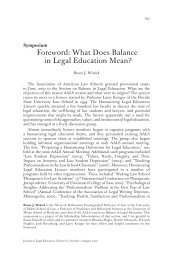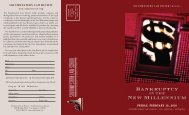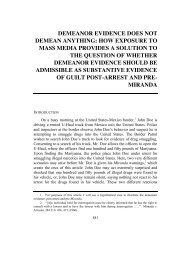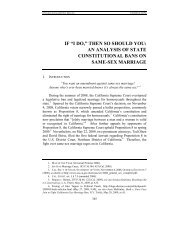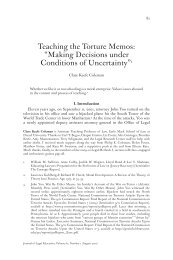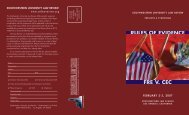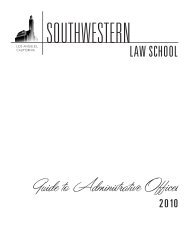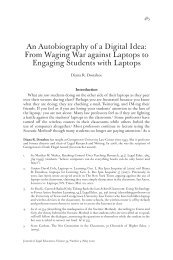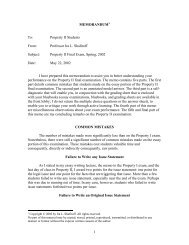What is Art? - Southwestern Law School
What is Art? - Southwestern Law School
What is Art? - Southwestern Law School
- No tags were found...
You also want an ePaper? Increase the reach of your titles
YUMPU automatically turns print PDFs into web optimized ePapers that Google loves.
124 J. INT’L MEDIA &ENTERTAINMENT LAW VOL. 4,NO. 21928 USA: Brâncuşi v. United States 61In the 1920s Brâncuşi began an exploration of the shapes of birds inflight. In 1923 he carved a work in marble that “concentrated not onthe physical attributes of the bird but on its movement. In Bird inSpace wings and feathers are eliminated, the swell of the body <strong>is</strong> elongated,and the head and beak are reduced to a slanted oval plane.Balanced on a slender conical footing, the figure’s upward thrust <strong>is</strong> unfettered.Brancusi’s inspired abstraction realizes h<strong>is</strong> stated intent tocapture ‘the essence of flight.’ Th<strong>is</strong> particular conception of Bird inSpace <strong>is</strong> the first in a series of seven sculptures carved from marbleand nine cast in bronze, all of which were painstakingly smoothedand pol<strong>is</strong>hed.” 62In 1926 a consignment of twenty Brâncuşi sculptures arrived atNew York by steamship from France, including a bronze version ofBird In Space. 63 US Customs demanded payment of import duty of40% of the market value of its bronze material as ‘merely a manufactureof metal’: around $230. Works of art could be imported duty freeunder the 1922 Tarrif Act. Brâncuşi filed suit claiming that h<strong>is</strong> workwas in law an ‘original sculpture’ and therefore exempt from importduty. 64 At the heart of the case lay the question: what <strong>is</strong> Modern <strong>Art</strong>?In 1928 a US Customs Court in New York ruled that Brâncuşi’ssculpture was a work of art, not an ‘article of utility’, as US Customshad claimed. Th<strong>is</strong> seminal trial, and especially its enlightened ruling,has been cited by art lawyers worldwide for eight decades as an iconiclegal precedent. Both parties called expert witnesses to attest whetherthe bronze artefact was indeed art. The US Customs appra<strong>is</strong>er had assertedthat “Several men, high in the art world were asked to expresstheir opinions for the Government and one of them told us, ‘If that’sart, hereafter I’m a bricklayer.’ Another said, ‘Dots and dashes areas art<strong>is</strong>tic as Brâncuşi’s work.’ In general, it was their opinion thatBrâncuşi left too much to the imagination.” Brâncuşi gave evidence61. Brancusi v. United States, 54 Treas. Dec. Cust. 428 (Cust. Ct. 1928).62. Catalogue entry of the Metropolitan Museum of <strong>Art</strong>, New York, which acquiredthe original marble sculpture in 1995 as a bequest from Florene M. Schoenborn,who had bought the work in 1942: 57 inches high, 6 1/2 inches diameter. A seriesof seven was made in marble. Nine were cast in bronze (two of which are in thecollection of Museum of Modern <strong>Art</strong>, New York, one at the Philadelphia Museum of<strong>Art</strong>). One sold at auction in the U.S. for $27.5 million in 2005, the then highest hammerprice for any sculpture.63. U.S. photographer Edward Steichen had bought the work in France and Brâncuşiarranged for it to be shipped to the United States, accompanied by the art<strong>is</strong>t’sfriend and colleague Marcel Duchamp.64. Marcel Duchamp suggested the lawsuit; Gertrude Vanderbilt Whitney financed it.




